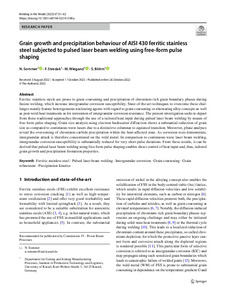| dc.date.accessioned | 2023-01-27T15:40:44Z | |
| dc.date.available | 2023-01-27T15:40:44Z | |
| dc.date.issued | 2022-10-26 | |
| dc.identifier | doi:10.17170/kobra-202301267424 | |
| dc.identifier.uri | http://hdl.handle.net/123456789/14390 | |
| dc.description.sponsorship | Gefördert im Rahmen des Projekts DEAL | ger |
| dc.language.iso | eng | eng |
| dc.rights | Namensnennung 4.0 International | * |
| dc.rights.uri | http://creativecommons.org/licenses/by/4.0/ | * |
| dc.subject | ferritic stainless steel | eng |
| dc.subject | pulsed laser beam welding | eng |
| dc.subject | intergranular corrosion | eng |
| dc.subject | grain coarsening | eng |
| dc.subject | grain refinement | eng |
| dc.subject | precipitation kinetics | eng |
| dc.subject.ddc | 600 | |
| dc.title | Grain growth and precipitation behaviour of AISI 430 ferritic stainless steel subjected to pulsed laser beam welding using free-form pulse shaping | eng |
| dc.type | Aufsatz | |
| dcterms.abstract | Ferritic stainless steels are prone to grain coarsening and precipitation of chromium-rich grain boundary phases during fusion welding, which increase intergranular corrosion susceptibility. State-of-the-art techniques to overcome these challenges mainly feature heterogeneous nucleating agents with regard to grain coarsening or alternating alloy concepts as well as post-weld heat treatments as for restoration of intergranular corrosion resistance. The present investigation seeks to depart from these traditional approaches through the use of a tailored heat input during pulsed laser beam welding by means of free-form pulse shaping. Grain size analysis using electron backscatter diffraction shows a substantial reduction of grain size as compared to continuous-wave lasers due to a distinctive columnar to equiaxed transition. Moreover, phase analyses reveal the overcoming of chromium carbide precipitation within the heat-affected zone. As corrosion tests demonstrate, intergranular attack is therefore concentrated on the weld metal. In comparison to continuous-wave laser beam welding, intergranular corrosion susceptibility is substantially reduced for very short pulse durations. From these results, it can be derived that pulsed laser beam welding using free-form pulse shaping enables direct control of heat input and, thus, tailored grain growth and precipitation formation properties. | eng |
| dcterms.accessRights | open access | |
| dcterms.creator | Sommer, Niklas | |
| dcterms.creator | Stredak, Florian | |
| dcterms.creator | Wiegand, Michael | |
| dcterms.creator | Böhm, Stefan | |
| dc.relation.doi | doi:10.1007/s40194-022-01398-y | |
| dc.subject.swd | Ferritischer Stahl | ger |
| dc.subject.swd | Edelstahl | ger |
| dc.subject.swd | Laserschweißen | ger |
| dc.subject.swd | Impulslaser | ger |
| dc.subject.swd | Interkristalline Korrosion | ger |
| dc.subject.swd | Kornwachstum | ger |
| dc.subject.swd | Kornfeinung | ger |
| dc.subject.swd | Ausscheidung | ger |
| dc.type.version | publishedVersion | |
| dcterms.source.identifier | eissn:1878-6669 | |
| dcterms.source.issue | Issue 1 | |
| dcterms.source.journal | Welding in the World | eng |
| dcterms.source.pageinfo | 51-62 | |
| dcterms.source.volume | Volume 67 | |
| kup.iskup | false | |


